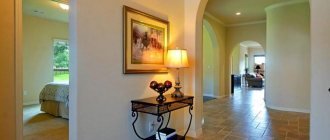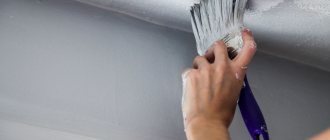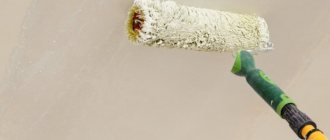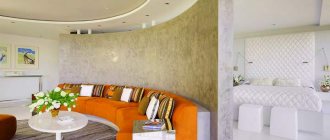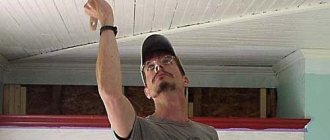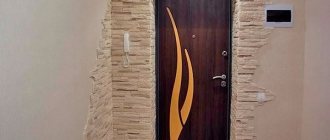The technology for finishing the ceiling in a country house has its own characteristics. The main distinguishing feature of the conditions of a country house is the seasonality of residence - that is, the temperature will vary over a fairly wide range. Of course, all options for dacha ceilings take this factor into account, and ready-made solutions are developed depending on it.
For the ceiling in a country house, different materials can be used, having both positive and negative qualities. In addition to analyzing the characteristics of the materials themselves, it is also worth understanding what the ceiling should be like. This article will discuss how to decorate the ceilings in the country house.
Requirements for the ceiling in the country
Any ceiling decoration in the country must meet a number of requirements:
- Low cost of materials and ceiling installation;
- Easy installation, allowing you to carry out all the work yourself using simple and accessible tools;
- Availability of materials required for finishing;
- Environmental safety of the materials used;
- Resistance to temperature changes;
- Long service life;
- Independence from regular care;
- Good decorative properties that allow you to implement the selected ceiling design in your dacha.
All options for finishing the ceiling in the country house meet these requirements to one degree or another. Of course, first of all you need to evaluate the technical characteristics of the materials used, and only then pay attention to secondary parameters.
There are several options applicable for finishing the ceiling in the country:
- Wood paneling;
- Sheathing with plastic panels;
- Formation of plasterboard structure;
- Sheathing with chipboard or other particle boards;
- Sheathing with plywood sheets;
- Installation of suspended ceilings;
- Plaster finishing.
Each of these finishing methods should be considered in detail to make it easier to decide how to finish the ceiling in the country house.
Advantages and disadvantages of wooden ceilings
The main advantage of finishing the ceiling with wood in an apartment is the environmental friendliness and naturalness of the material.
In addition, wood finishing boasts other advantages:
- Untreated wood is susceptible to damage by insects, quickly absorbs moisture, deforms and burns. Thanks to modern drying methods and special impregnations, the material is free of all these disadvantages, which extends its service life.
- The beauty of texture and color are also considered advantages of wood finishing.
- The material is easy to cut, install and can be processed in various ways.
- Natural wood regulates the microclimate in the room and maintains it at an optimal level for humans. This is ensured by the fact that wood absorbs moisture when the humidity in the room increases and releases it when it decreases.
- Wooden ceiling trim additionally protects the room from cold and external noise.
- Wood finishing can be used to decorate interiors in different styles.
- Some options for wooden ceiling cladding can be made with your own hands from budget materials.
Wooden lining
A dacha is primarily a country house, the decoration of which most often uses “rustic” solutions. The answer to the question of how to make a ceiling in a country house is obvious in this case. The predominant finishing material is wood, so its use for finishing the ceiling seems quite logical and justified. There are many options for wood finishing, but the most common of them is lining.
The advantages of wooden lining over analogues are as follows:
- Comparative ease of self-installation;
- Installation requires only simple tools that every owner has, and a small amount of consumables that allow you to mount the frame and planks;
- Possibility of hidden installation of communications - for example, electrical wiring for connecting lighting;
- Good decorative properties, which turn out to be especially relevant in country houses - a wooden ceiling in a country house looks very organic;
- Environmentally friendly material - natural wood is used to make the lining.
However, this material also has a number of disadvantages, and quite serious ones when it comes to finishing the ceiling in a country house:
- Good lining is quite expensive;
- Wooden lining does not withstand constant temperature changes;
- When the air humidity in the room is high, a self-made ceiling made from this type of material begins to swell, rot and become moldy.
Having an idea of the advantages and disadvantages of wooden lining, we can put it this way - this material is suitable for quick and high-quality finishing of the ceiling. The installation technology is identical to the arrangement of various suspended structures, i.e. the outer parts of the ceiling are attached to the lathing, assembled from wooden slats or metal profiles.
If necessary, soundproofing materials and insulation can be placed in the cells of the frame. In addition, various communications can be located in this space, for example, wiring or fire detectors. If there is no need to fill the frame, then the lining can be attached directly to the ceiling - in this case, the ceiling height will practically not decrease. Lining also makes it possible to implement a retro style, in which the wiring is not under the covering, but outside, in special decorative details.
Before covering the ceiling in a dacha with clapboard, the sheathing must be covered with a layer of vapor barrier, which is easiest to fasten with a stapler. The lining itself is fixed to the ceiling using clamps, originally designed for fastening wooden parts, or ordinary small self-tapping screws.
When choosing lining for finishing the ceiling in your dacha, you should definitely remember the weak points of this material. Wood does not withstand temperature changes and high humidity. To protect the ceiling from the effects of these factors, all its parts must be thoroughly treated with an antiseptic before installation, and then covered with a protective varnish.
Wooden ceilings
Such ceilings are a sheathed structure covered with eurolining, panels, split timber or individual wooden elements. They are mounted with a small gap, if necessary closed with special putties or moisture-proof compounds. Provided they are properly processed, they can be used in any residential premises, including unheated and humid ones.
The main advantages of wooden ceilings include:
- Environmental cleanliness and safety, ensuring a favorable microclimate and air exchange. The latter is especially important when arranging ceilings in bedrooms and children's rooms.
- Possibility of hiding insulation or acoustic substrate, good thermal and sound insulation capabilities.
- Respectable and original appearance. Wooden ceilings can be painted with both transparent and tinted varnishes, paints and waxes; when using high-quality paints and proper care, they remain attractive for a long time and do not need updating.
The disadvantages of wooden ceilings include the need for reliable protection from moisture, fire and biological influences; the quality of processing of cladding materials directly affects the service life of the structure. The costs of their installation depend on the value of the selected wood, the cost of protective and decorative materials and the prices of the craftsmen. When performing this work on your own, significant savings are achieved; wooden ceilings cannot definitely be classified as expensive types.
The opinion that these ceilings are incompatible with certain types of interiors is erroneous. With the right approach, wood fits into any modern style, even high-tech. In addition to covering the ceiling with clapboard and then painting it in any color (the simplest and most cost-effective way), owners can decorate the ceilings with wooden panels, boards and volumetric structures and combine them with other materials.
An interesting decorative effect is achieved by emphasizing nature’s beauty of wood with special waxes, forming relief or patterned structures, and arranging coffered ceilings. If it is impossible to install such ceilings in an apartment, owners should consider the pros and cons of alternative options, namely, covering their surfaces with veneer, bamboo or cork wallpaper.
Plastic panels
If the key factor is the cost of finishing, then the best solution would be plastic panels - they are cheaper than all other materials. Structurally, such panels are very similar to lining, but polyvinyl chloride is used for their manufacture, rather than natural wood.
Comparing these materials, we can note a number of advantages of plastic parts over wooden ones:
- Almost complete protection from temperature changes and humidity, which is especially important in the case of housing that is used seasonally;
- Good protection from biological damage (but to realize this advantage, certain care is required, otherwise mold will form in the gaps between the panels);
- Easy to use and wet cleaning possible;
- Light weight of the final structure, which allows you to make a less massive frame;
- A wide selection of colors and textures, which makes it possible to visually combine the ceiling with the finish of other surfaces of the room.
In addition to positive qualities, there are also negative ones. Thus, plastic panels do not survive exposure to ultraviolet radiation well - due to direct sunlight, the coating begins to turn yellow. It is also worth noting the lack of vapor permeability, due to which active formation of condensation on the ceiling becomes possible in case of poor ventilation of the room.
To install PVC panels, you can do without hardware - ordinary self-tapping screws will be enough. An important point is that the screws are screwed in so that their heads press the panel against the guides. This fastening method avoids damage to the panels, so they can be dismantled if necessary.
Floor preparation
Before finishing the ceiling in a private house, you need to prepare the base surface and the entire ceiling. Unlike an apartment in a high-rise building, the ceiling of a private house requires additional insulation and protection from condensation and moisture.
That is why before finishing the ceiling cladding, take care of the following:
- lay thermal insulation material between the floor beams (this is especially important if there is an unheated attic above);
- a layer of vapor barrier is laid above the ceiling to ensure the removal of condensate that accumulates in the thermal insulation material due to temperature changes;
- Below the insulation, a layer of waterproofing is attached to the beams, which will protect the structure from moisture evaporating from the room and rising upward.
Plasterboard ceilings
One of the most durable and reliable ceiling structures is a plasterboard ceiling. This design is perfect for those cases where there is a need to integrate LED lamps or spot lighting. A distinctive feature of such ceilings is that there is no need for preliminary leveling of the ceiling - the box will completely hide it.
The main advantages of plasterboard ceilings look like this:
- High installation speed
. This parameter is largely determined by the large size of the material used. Standard plasterboard sheets have dimensions of 250x120 cm, so the number of actions required for work is reduced several times. - Good appearance
. A plasterboard suspended ceiling in a country house by itself does not look very attractive, but it is customary to apply a finishing touch on top of the sheets using, for example, paint or putty. The final design will look pretty good if you put some effort into it.
There are quite a lot of disadvantages, and they are especially relevant in dacha conditions:
- The material does not withstand seasonal use well due to its low resistance to severe temperature changes and high humidity;
- For proper installation of a plasterboard structure, experience in carrying out such work is required;
- The cost of finishing is quite high;
- When using paint as a finishing touch, you will have to periodically repair the ceiling in your dacha - such compositions are not very durable.
To install drywall on the ceiling, you must first assemble a wooden or metal frame. The sheets themselves on the ceiling are positioned offset relative to each other so that the final strength of the structure is higher. The sheets are fixed using self-tapping screws, which need to be screwed in increments of about 20 cm around the perimeter of the sheathing.
The assembled structure is finished with putty, and a reinforcing mesh is mounted at the joints of the sheets. The putty layer must be sanded and treated with a primer, after which the casing can be painted. If there is a high level of humidity in the room, then instead of ordinary drywall, it is better to take moisture-resistant one - it is more durable and reliable.
Finishing
Let us briefly consider the main finishing methods and the installation process of all the materials described above. Only the installation of suspended ceilings does not require explanation, since all work will be performed by specialists from the company from which the canvas was ordered. Almost nothing is required from the owner of the house other than monitoring their work.
- Lining
Mounted on a pre-assembled sheathing. For fastening, you can use nails or screws. The latter are somewhat preferable, as they will hold the coating parts more tightly.
- Drywall
It refers to materials that require the construction of a special foundation for installation. You can attach the sheets to a regular wooden sheathing, but it is better to assemble the base from metal profiles.
It all starts with him. The frame parts are attached to the ceiling using special hanging fasteners. A special profile is installed around the perimeter of the room, which will serve as a guide when drawing out the ceiling plane.
When the frame is assembled, plasterboard sheets are hemmed onto it. They are attached with a slight offset relative to each other along the length. This will avoid cracking of the outer finishing layer at the joints, which must be carefully puttied after installation. The whole finishing is completed with decorative materials - putty, paint, wallpaper or textured plaster.
- Panels
A variety of panel coverings are another option for lining the ceiling in your dacha. Plastic or MDF, they are mounted on a frame base. Its installation takes place according to the same scheme as when assembling a structure from gypsum plasterboard.
When it is assembled, the panels themselves begin to be screwed to it with self-tapping screws. They are fastened in such a way that the protrusion of each subsequent part fits into the groove on the previous one. After installing all the covering elements, a decorative plinth is installed around the perimeter of the room.
One of the methods for installing such coverings does not involve assembling the frame. In this case, the parts are mounted on the sheathing, like wooden lining, and attached in the same way as on the frame. This method is a little cheaper and less labor intensive.
- Foam Tiles
There is no hassle with them at all. This coating is installed by gluing tiles to any surface. The most important thing is the correct choice of glue. It must withstand exposure to humid air and firmly hold the glued tiles. In addition, it should not contain caustic components that can melt the foam.
- Plywood
It is also attached to a pre-constructed base, but after the entire surface of the covering has been assembled, the plywood requires additional processing. This can be varnish, if you intend to preserve the natural grain of the wood, or painting.
Chipboard ceiling
Wood chipboards are chipboard and OSB. Both materials are quite suitable for arranging a ceiling, but it must be taken into account that they are characterized by poor resistance to moisture and a high concentration of formaldehyde. However, these shortcomings can be partially mitigated by covering the finished structure with putty.
When figuring out which ceiling is better in a country house, it is worth noting that particle boards are far from the best option. The problem lies in the seasonal use of the dacha - the coating layer will peel off and fall off with constant changes in operating conditions. In order for the ceiling to perform its functions normally, it will have to be puttied at least once every two years.
Plywood ceiling
To make the ceiling both reliable and durable, you can use a simple solution that involves the use of plywood. Of course, you need to take good material - laminated multi-layer plywood is quite suitable.
This material has a number of advantages:
- Environmental safety, which is determined by low formaldehyde emissions (at least in comparison with wood chip products);
- High strength sheets and resistance to moisture;
- Good decorative properties that allow you to do without finishing;
- Relatively light weight, which reduces the load on the frame and simplifies the installation of the ceiling.
Perhaps the only drawback of plywood is its high cost - other finishing materials are much cheaper.
Installation of a plywood ceiling can be done in two ways:
- Installation of plywood sheets on a pre-mounted sheathing on the ceiling;
- Fastening directly to the floor joists (this method is only possible if the joists are perfectly aligned).
The first method, in its technology, is very similar to the technology of arranging a plasterboard ceiling. The similarity lies in one of the advantages of this method - the unevenness of the ceiling will eventually disappear and will not have any significance. The second method is usually used if it is impossible to lower the ceiling further.
After installation, the gaps between the individual sheets are covered with putty designed for use with wooden parts - this method allows you to paint the ceiling in the future. In the case of laminated plywood, plastic joint strips can be used to mask gaps. It is best to cover the screw caps with plastic plugs.
Whitewash
Previously, the ceiling in the house was finished only with whitewash, but now other, higher quality ceiling coverings and their types have appeared. Nevertheless, this option is still in demand due to its versatility. The white surface will fit into any interior. In addition, the cost of whitewashing is the lowest of all finishing materials. The finishing process itself is also very simple, so you can save on the services of specialists. Among the disadvantages, it is worth noting the need for careful surface preparation. Also, whitewash tends to constantly crumble, so the surface needs to be renewed regularly.
Whitewashing the ceiling
Stretch ceiling
Stretch ceiling is one of the best solutions for a summer residence. There are two main types of suspended ceilings - film and fabric. Of course, before you make a ceiling from fabric or film with your own hands, you need to carefully understand their features.
The cost of film ceilings is not very high, despite the need to invite specialists - film ceilings are very difficult to install on your own, since this requires special equipment and experience in working with it.
A ceiling with a stretch fabric is quite durable and practically does not lose its decorative properties over time. In addition, it can be washed without problems. Installation takes minimal time if you have experience. The only drawback worth noting is the smell of plastic, which will completely disappear from the room in about a week. However, even this drawback can be mitigated by arranging fabric stretch ceilings with your own hands.
Fabric ceilings are quite good, but textiles do not withstand moisture very well and begin to mold over time. However, a fabric stretch ceiling can also be considered as a good solution for a summer residence - but before you make a fabric ceiling, it is worth studying in more detail the features of this design.
Finishing the ceiling with plaster
Finally, the last method, which was previously used to finish ceilings almost everywhere, is finishing with plaster. Structurally, this finish is a layer of plaster a couple of centimeters thick, which is applied to the surface of the ceiling to completely level it.
Plaster can be used to finish any floors, regardless of the material they are made of. However, if we are talking about covering a wooden ceiling, then you first need to fill it with lathing or attach a reinforcing mesh. Plaster can be applied only after the ceiling has been prepared.


